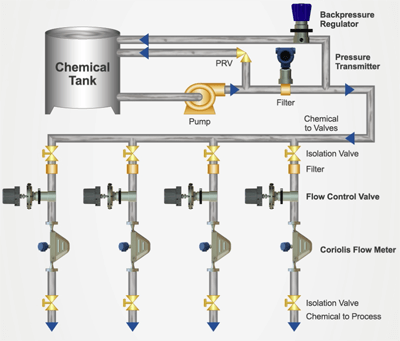Take a moment and ask yourself: How much does my company spend every year on chemicals? For most, chemical injection is a sunk cost of production–it’s a cost that’s hard to tackle because few of us are chemists. Both the dosage of chemical and the amount spent on chemical is difficult to determine!
But in today’s low oil price environment, a critical examination of your chemical injection system and practices may yield tremendous OPEX savings. Chemicals are a necessary expense–without preventive chemicals, scales and waxes could plug tubing, shutdown facilities, hydrates could block production, which could cost up to $1M/day in shut-in production as its dissociated.
Without a corrosion inhibitor, complete loss of a well or infrastructure could occur over time. With such severe consequences, producers consistently inject more than the recommended quantity of chemical.
In one case I worked with, a producer was over-injecting demulsifier by 50% to be certain that an emulsion didn’t form and shutdown the production facilities. A sampling of producers interviewed showed that chemical is typically over-injected by ~20%. And the annual cost of over injection for a chemical run at an additional 20% could be as high as $400k for a single well! Over injection also means additional field trips to replenish the chemicals in the storage tanks.
Whether you’re operating onshore or offshore, millions of dollars a year are wasted on chemicals.
So what are the primary challenges with your chemical injection system preventing you from injecting chemicals at recommended quantities rather than over-injecting?
What I’ve heard from the industry is that primary obstacles to system reliability include ‘injection rate drift’–mechanically from the pump or valve controlling flow–these items change their rates based on back-pressure in the system or wear of their parts and seals.
As one operator in the Gulf of Mexico noted, they needed to employ one technician just to monitor and
adjust chemical injection rates every 4 hours. Chemically, as temperatures change, chemical viscosity can change, resulting in a drift in the actual chemical injected versus indicated rate. Plugging issues, whether due to chemical quality, precipitates or failed filters, can result in under-injection of chemical and potentially major shutdowns.
Some equipment can be very maintenance-intensive, especially at start up and shutdown. A North Sea Operator noted that the injection control devices experienced constant failure due to frequent startups and shutdowns. Another challenge noted is the wide turndown required over the life of the well. Many valves and flow meters have a limited turndown that does not serve the range of expected flow rates over the life of the well–particularly as the asset declines or enters secondary or tertiary recovery. And lastly, space and weight for offshore systems. Space and weight are at a premium offshore so any reduction in equipment size and weight can result in significant upfront CAPEX savings in the installation itself.
What if you could:
- Improve system reliability–be confident in your chemical injection system and know that you’re injecting exactly what the equipment says you’re injecting
- Because you’ve improved reliability, you can begin to reduce chemical costs and only inject what you need to inject–take those lab reports or chemical provider recommendations and comfortably and confidently inject just what you need rather than over-inject for comfort
- And once you’ve improved the system, increase operational efficiency
- Reduce safety risks as you have fewer folks driving from well to well onshore to check on chemicals and offshore, and reduce exposure to hydrate plugs, scales and corrosion as you inject at a level that’s just right with minimized risk of plugging or equipment failure
So how can Emerson help?
Sensitive to all your concerns whether offshore or onshore, including space and weight, more challenging conditions with higher temperatures and pressures, and project certainty on schedule and cost, Emerson offers both monitoring and control solutions for chemical injection. These solutions will dramatically improve the reliability of your chemical injection system and provide the certainty of injection needed to reduce the amount that you over-inject–dropping operating dollars to your bottom-line as soon as possible.
Using a highly accurate and reliable Tescom flow control valve coupled with a Micro Motion Coriolis flow meter for monitoring, is ideal for confidently and accurately dosing at prescribed dosage rates (rather than over-injecting). Coupling the control and monitoring of the chemical injection system with a Roxar downstream corrosion probe can help you identify the minimum amount of corrosion inhibitor required to protect your downstream assets, further improving your bottom-line. And with pressure ratings available up to 15,000 psi, we’ve got even your deepest assets covered.
Visit our booth number 5817 at the May 2-5, 2016 Offshore Technology Conference and we can discuss these solutions with you and your team. Register to receive a complementary OTC day pass for more on this and other oil and gas solutions.






